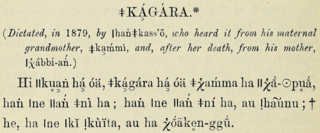Chao tone letters (IPA)

A series of iconic tone letters based on a musical staff was devised by Yuen Ren Chao in the 1920s [2] by adding a reference stave to the existing convention of the International Phonetic Alphabet. The stave was adopted by the IPA as an option in 1989 and is now nearly universal. [3] When the contours had been drawn without a staff, it was difficult to discern subtle distinction in pitch. Only nine or so of the possible tones were commonly distinguished: high, medium and low level, [ˉa˗aˍa] (or as dots rather than macrons for 'unaccented' tones); high rising and falling, [ˊaˋa]; low rising and falling, [ˏaˎa]; and peaking and dipping, [ˆaˇa], though more precise notation was found and the IPA specifically provided for mid rising and falling tones if needed. [4] The Chao tone letters were originally x-height, but are now taller to make distinctions in pitch more visible.
Combinations of the Chao tone letters form schematics of the pitch contour of a tone, mapping the pitch in the letter space and ending in a vertical bar. For example, [ma˨˩˦] represents the mid-dipping pitch contour of the Chinese word for horse, 馬/马mǎ. Single tone letters differentiate up to five pitch levels: ˥ 'extra high' or 'top', ˦ 'high', ˧ 'mid', ˨ 'low', and ˩ 'extra low' or 'bottom'. No language is known to depend on more than five levels of pitch.
These letters are most commonly written at the end of a syllable. [5] [6] For example, Standard Mandarin has the following four tones in syllables spoken in isolation:
| Tone description | Tone letter | Chao tone numerals | Tone number | Pinyin | Traditional Chinese | Simplified Chinese | Gloss |
|---|---|---|---|---|---|---|---|
| High level | ma˥˥ | ma55 | ma1 | mā | 媽 | 妈 | mother |
| Mid rising | ma˧˥ | ma35 | ma2 | má | 麻 | 麻 | hemp |
| Low dipping | ma˨˩˦ | ma214 | ma3 | mǎ | 馬 | 马 | horse |
| High falling | ma˥˩ | ma51 | ma4 | mà | 罵 | 骂 | scold |
For languages that have simple register tones in basic morphemes, or on short vowels, single tone letters are used for these, and the tone letters combine as the tones themselves do to form contours. For example, Yoruba has the three basic tones [˥˧˩] on short vowels and the six derived contour tones [˥˧˥˩˧˥˧˩˩˧˩˥] on long vowels, diphthongs and contractions. On the other hand, for languages that have basic contour tones, and among these are level tones, it's a common convention to use double tone letters for those level tones, and single tone letters for short checked tones, as in Taiwanese Hokkien [sã˥˥] vs [tit˥]. The tones [˥˥] and [˥] are generally analyzed as being the same phoneme, and the distinction reflects traditional Chinese classification; it also derives from the convention of numerically writing ⟨sã55⟩ for high level pitch vs ⟨sã5⟩ for tone #5. Regardless, this is not an IPA convention.
Chao tone letters are sometimes written before the syllable, in accordance with writing stress and downstep before the syllable, and as had been done with the unstaffed letters in the IPA before 1989. For example, the following passage transcribes the prosody of European Portuguese using tone letters alongside stress, upstep, and downstep in the same position before the syllable: [7]
- [uꜛˈvẽtuˈnɔɾtɯkumɯˈsoɐsuˈpɾaɾkõˈmũitɐ˩˧fuɾiɐ|mɐʃꜛˈku̯ɐ̃tumaiʃsu˩˧pɾavɐ|maizꜛuviɐꜜˈʒɐ̃tɯsiɐkõʃꜜˈɡavasuɐ˧˩kapɐ|ɐˈtɛꜛkiuˈvẽtuˈnɔɾtɯ˧˩d̥z̥ʃtiuǁ]
- O vento norte começou a soprar com muita fúria, mas quanto mais soprava, mais o viajante se aconchegava à sua capa, até que o vento norte desistiu.
The two systems may be combined, with prosodic pitch written before a word or syllable and lexical tone after a word or syllable, since in the Sinological tradition the tone letters following a syllable are always purely lexical and disregard prosody.
Diacritics may also be used to transcribe tone in the IPA. For example, tone 3 in Mandarin is a low tone between other syllables, and can be represented as such phonemically. The four Mandarin tones can therefore be transcribed /má,mǎ,mà,mâ/. (These diacritics conflict with the conventions of Pinyin, which uses the pre-Kiel IPA diacritic conventions: ⟨mā, má, mǎ, mà⟩, respectively)
Reversed Chao tone letters
Reversed Chao tone letters indicate tone sandhi, with the right-stem letters on the left for the underlying tone, and left-stem ('reversed') letters on the right for the surface tone. For example, the Mandarin phrase nǐ/ni˨˩˦/ + hǎo/xaʊ˨˩˦/ > ní hǎo/ni˧˥xaʊ˨˩˦/ is transcribed:
- ⫽ni˨˩˦꜔꜒xaʊ˨˩˦⫽
Some transcribers use reversed tone letters to show that they apply to the following rather than the preceding syllable. For example, Kyoto Japanese ame 'rain' may be transcribed,
- ꜖a꜒꜔me
rather than a˩me˥˧. [8]
Reversed tone letters were adopted by the IPA in 1989, though they do not appear in the space-limited IPA chart. [9]
The phonetic realization of neutral tones are sometimes indicated by replacing the horizontal stroke with a dot: ⟨꜌ ꜋ ꜊ ꜉ ꜈⟩. When combined with tone sandhi, the same letters may have the stem on the left: ⟨꜑ ꜐ ꜏ ꜎ ꜍⟩. This is an extension of the pre-Kiel IPA convention of a dot placed at various heights to indicate the pitch of a reduced tone.
Chao defined the pitch trace as indicating a 'toneme' when to the left of the stave, and as a 'tone value' when to the right. However, 'tone value' is not precisely defined, and in his examples may be phonemic. His illustrations use left- and right-facing tone letters as follows:
- English jes꜓꜕,jes꜒꜖,jes꜕꜓,ɦjes꜖꜖ etc: different intonations of the response 'yes'
- Cantonese i˩˩kɑ˦˨꜒꜒: a phonemic change in tone due to sandhi in a compound word
- Lhasa Tibetan lɑkɑ˩˧˩wɛ > lɑ꜖꜖kɑ꜔꜒wɛ꜕꜕: the spread of an underlying peaking tone on kɑ across adjacent syllables
The Tibetan distinction is a phonemic-phonetic one; the Cantonese distinction is not.




